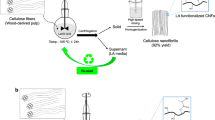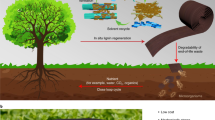Abstract
In this work, poly(methacrylated vanillin) (PMV) was investigated for its reactivity in multicomponent reactions as a reactive polymer that can be sourced from lignin-based components. To achieve sustainable polymer chemistry, the PMV reactivity in a Passerini three-component reaction (Passerini-3CR) was investigated because the reactants in the Passerini-3CR can be abundantly sourced from biobased compounds. First, the Passerini-3CR of the PMV in solution phases revealed that the PMV pendant aldehydes can be converted into the corresponding α-acyloxy amides with >90% conversions under the optimized conditions. Taking advantage of this high reactivity of PMV, its immobilized cellulose fabric (Cell-g-PMV), a wood biomass-sourced organic hybrid, was subjected to the Passerini-3CR. Although the aldehydes were not completely converted, the PMV segments surrounding the fabric surfaces successfully reacted via the Passerini-3CR to engraft carboxylic acid and isocyanide components on the cellulose-based fabrics.
This is a preview of subscription content, access via your institution
Access options
Subscribe to this journal
Receive 12 print issues and online access
$259.00 per year
only $21.58 per issue
Buy this article
- Purchase on Springer Link
- Instant access to full article PDF
Prices may be subject to local taxes which are calculated during checkout








Similar content being viewed by others
References
Lee SH, Kang JS, Kim D. A mini review: recent advances in surface modification of porous silicon. Materials. 2018;11. https://doi.org/10.3390/ma11122557.
Ma W, Yah WO, Otsuka H, Takahara A. Surface functionalization of aluminosilicate nanotubes with organic molecules. Beilstein J Nanotechnol. 2012;3:82–100. https://doi.org/10.3762/bjnano.3.10.
Ragauskas AJ, Beckham GT, Biddy MJ, Chandra R, Chen F, Davis MF, et al., Lignin valorization: improving lignin processing in the biorefinery. Science. 2014;344. https://doi.org/10.1126/science.1246843.
Klemm D, Heublein B, Fink H-P, Bohn A. Cellulose: fascinating biopolymer and sustainable raw material. Angew Chem Int Ed 2005;44:3358–93. https://doi.org/10.1002/anie.200460587.
Kopetz H. Renewable resources: build a biomass energy market. Nature. 2013;494:29–31. https://doi.org/10.1038/494029a.
Holmberg AL, Reno KH, Nguyen NA, Wool RP, Epps TH. Syringyl methacrylate, a hardwood lignin-based monomer for High-Tg polymeric materials. ACS Macro Lett. 2016;5:574–8. https://doi.org/10.1021/acsmacrolett.6b00270.
Holmberg AL, Stanzione JF, Wool RP III, Epps TH III. A facile method for generating designer block copolymers from functionalized lignin model compounds. ACS Sustain Chem Eng. 2014;2:569–73. https://doi.org/10.1021/sc400497a.
Zhou J, Zhang H, Deng J, Wu Y. High glass-transition temperature acrylate polymers derived from biomasses, syringaldehyde, and vanillin. Macromol Chem Phys. 2016;217:2402–8. https://doi.org/10.1002/macp.201600305.
Holmberg AL, Nguyen NA, Karavolias MG, Reno KH, Wool RP, Epps TH. Softwood lignin-based methacrylate polymers with tunable thermal and viscoelastic properties. Macromolecules. 2016;49:1286–95. https://doi.org/10.1021/acs.macromol.5b02316.
Holmberg AL, Karavolias MG, Epps TH III. RAFT polymerization and associated reactivity ratios of methacrylate-functionalized mixed bio-oil constituents. Polym Chem. 2015;6:5728–39. https://doi.org/10.1039/C5PY00291E.
Kakuchi R, Yoshida S, Sasaki T, Kanoh S, Maeda K. Multi-component post-polymerization modification reactions of polymers featuring lignin-model compounds. Polym Chem. 2018;9:2109–15. https://doi.org/10.1039/C7PY01923H.
Hamada T, Yamashita S, Omichi M, Yoshimura K, Ueki Y, Seko N, et al. Multicomponent-reaction-ready biomass-sourced organic hybrids fabricated via the surface immobilization of polymers with lignin-based compounds. ACS Sustain Chem Eng. 2019;7:7795–803. https://doi.org/10.1021/acssuschemeng.8b06812.
Deng X-X, Li L, Li Z-L, Lv A, Du F-S, Li Z-C. Sequence regulated poly(ester-amide)s based on passerini reaction. ACS Macro Lett. 2012;1:1300–3. https://doi.org/10.1021/mz300456p.
Kakuchi R, Theato P. Efficient multicomponent postpolymerization modification based on Kabachnik-fields reaction. ACS Macro Lett. 2014;3:329–32. https://doi.org/10.1021/mz500139c.
Kreye O, Türünç O, Sehlinger A, Rackwitz J, Meier MAR. Structurally diverse polyamides obtained from monomers derived via the Ugi multicomponent reaction. Chem Eur J. 2012;18:5767–76. https://doi.org/10.1002/chem.201103341.
Li L, Kan X-W, Deng X-X, Song C-C, Du F-S, Li Z-C. Simultaneous dual end-functionalization of peg via the passerini three-component reaction for the synthesis of ABC miktoarm terpolymers. J Polym Sci Part A. 2013;51:865–73. https://doi.org/10.1002/pola.26443.
Kreye O, Tóth T, Meier MAR. Introducing multicomponent reactions to polymer science: Passerini reactions of renewable monomers. J Am Chem Soc. 2011;133:1790–2. https://doi.org/10.1021/ja1113003.
Lee I-H, Kim H, Choi T-L. Cu-catalyzed multicomponent polymerization to synthesize a library of poly(N-sulfonylamidines). J Am Chem Soc. 2013;135:3760–3. https://doi.org/10.1021/ja312592e.
Jee J-A, Spagnuolo LA, Rudick JG. Convergent synthesis of dendrimers via the Passerini three-component reaction. Org Lett. 2012;14:3292–5. https://doi.org/10.1021/ol301263v.
Deng XX, Cui Y, Du FS, Li ZC. Functional highly branched polymers from multicomponent polymerization (MCP) based on the ABC type Passerini reaction. Polym Chem. 2014;5:3316–20. https://doi.org/10.1039/c3py01705b.
Zhao Y, Yang B, Zhu CY, Zhang YL, Wang SQ, Fu CK, et al. Introducing mercaptoacetic acid locking imine reaction into polymer chemistry as a green click reaction. Polym Chem. 2014;5:2695–9. https://doi.org/10.1039/c4py00058g.
Zhu C, Yang B, Zhao Y, Fu C, Tao L, Wei Y. A new insight into the Biginelli reaction: the dawn of multicomponent click chemistry? Polym Chem. 2013;4:5395–400. https://doi.org/10.1039/C3PY00553D.
Kakuchi R. Multicomponent reactions in polymer synthesis. Angew Chem Int Ed. 2014;53:46–8. https://doi.org/10.1002/anie.201305538.
Rudick JG. Innovative macromolecular syntheses via isocyanide multicomponent reactions. J Polym Sci Part A. 2013;51:3985–91. https://doi.org/10.1002/Pola.26808.
Yang B, Zhao Y, Wei Y, Fu C, Tao L. The Ugi reaction in polymer chemistry: syntheses, applications and perspectives. Polym Chem. 2015;6:8233–9. https://doi.org/10.1039/C5PY01398D.
Kakuchi R. The dawn of polymer chemistry based on multicomponent reactions. Polym J. 2019;51:945–53. https://doi.org/10.1038/s41428-019-0209-0.
Pettignano A, Daunay A, Moreau C, Cathala B, Charlot A, Fleury E. Sustainable modification of carboxymethyl cellulose by passerini three-component reaction and subsequent adsorption onto cellulosic substrates. ACS Sustain Chem Eng. 2019;7:14685–96. https://doi.org/10.1021/acssuschemeng.9b02634.
Khine YY, Ganda S, Stenzel MH. Covalent tethering of temperature responsive pNIPAm onto TEMPO-Oxidized cellulose nanofibrils via three-component Passerini reaction. ACS Macro Lett. 2018;7:412–8. https://doi.org/10.1021/acsmacrolett.8b00051.
Ramozzi R, Morokuma K. Revisiting the passerini reaction mechanism: existence of the nitrilium, organocatalysis of its formation, and solvent effect. J Org Chem. 2015;80:5652–7. https://doi.org/10.1021/acs.joc.5b00594.
Maeda S, Komagawa S, Uchiyama M, Morokuma K. Finding reaction pathways for multicomponent reactions: the Passerini reaction is a four-component reaction. Angew Chem Int Ed. 2011;50:644–9. https://doi.org/10.1002/anie.201005336.
Acknowledgements
RK profoundly acknowledges the Leading Initiative for Excellent Young Researchers (LEADER) and a Grant-in-Aid for Scientific Research (C) (no. 19K05578) for financial support. MO also profoundly acknowledges the JSPS Bilateral Joint Research Project (JPJSBP 120208601) and QST President's Strategic Grant Exploratory Research for financial support.
Author information
Authors and Affiliations
Corresponding authors
Ethics declarations
Conflict of interest
We declare that there are no conflicts of interest to this work.
Additional information
Publisher’s note Springer Nature remains neutral with regard to jurisdictional claims in published maps and institutional affiliations.
Rights and permissions
About this article
Cite this article
Kakuchi, R., Tsuji, R., Fukasawa, K. et al. Polymers of lignin-sourced components as a facile chemical integrant for the Passerini three-component reaction. Polym J 53, 523–531 (2021). https://doi.org/10.1038/s41428-020-00448-w
Received:
Revised:
Accepted:
Published:
Issue Date:
DOI: https://doi.org/10.1038/s41428-020-00448-w
This article is cited by
-
Synthesis of photoresponsive biobased adhesive polymers via the Passerini three-component reaction
Polymer Journal (2023)
-
PJ ZEON Award for outstanding papers in Polymer Journal 2021
Polymer Journal (2022)



